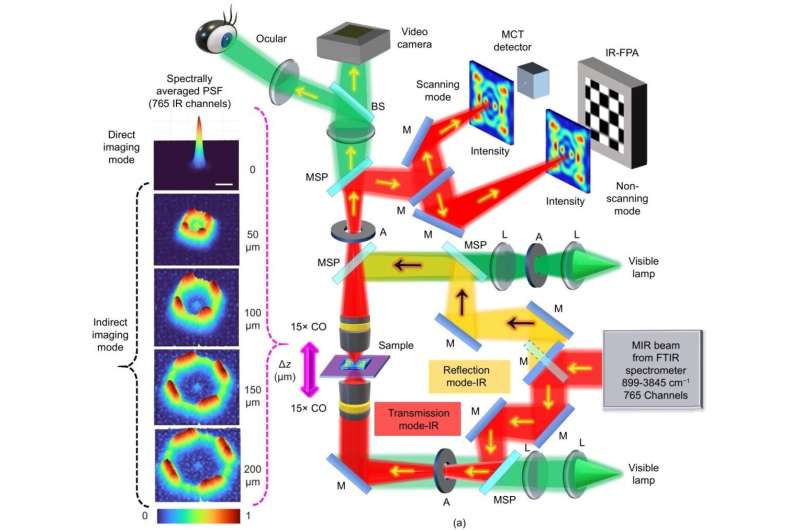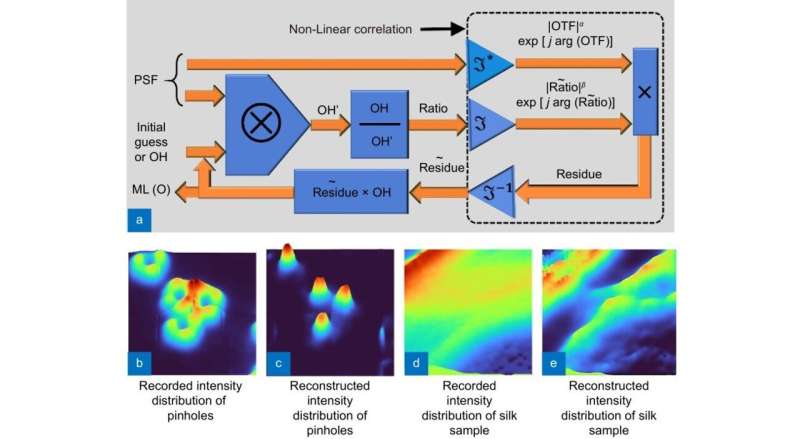This article has been reviewed according to Science X's editorial process and policies. Editors have highlighted the following attributes while ensuring the content's credibility:
fact-checked
proofread
Adding dimensions with Lucy–Richardson–Rosen algorithm to incoherent imaging

Coded aperture imaging (CAI) is another incoherent imaging technique developed in the 20th century to achieve lensless 2D imaging with nonvisible wavelengths. In CAI, the light from an object is modulated by a coded mask and recorded. The recorded intensity distribution is processed with the point spread function (PSF) recorded under identical conditions to reconstruct the object image.
An IDH technique using CAI called coded aperture correlation holography (COACH) was developed in 2016, wherein the light from an object is modulated by a random phase mask and interfered with an unmodulated object wave. In COACH, there is no numerical image plane unlike its precursors. Therefore, the reconstruction technique of CAI was mandatory, which involves the recording of point spread holograms (PSHs) along all axial planes, followed by computational processing of the object hologram with the PSHs. At this point, a connection between CAI and IDH was established.
Later, it was found by the research group that the 3D information is encoded in both the amplitude and the phase of the light diffracted by the random phase mask. This led to the development of a simpler version of COACH called interferenceless COACH (I-COACH). I-COACH had the advantages of both IDH and CAI, that is, 3D imaging capability and simple optical architecture, respectively. The research is published in the journal Opto-Electronic Advances.
One drawback with I-COACH is the low SNR due to scattering by the random phase mask, which makes it unsuitable for light-sensitive applications and complicated microscope configurations. The main reason for using a random phase mask in I-COACH is that the intensity distribution obtained by scattering has sharp autocorrelation functions and low cross-correlation along depth (SALCAD).
During an attempt to apply I-COACH to the infrared microscope (IRM) of the Australian Synchrotron, it was found that the Cassegrain objective lens exhibited the SALCAD property except with a higher SNR than a random phase mask. This discovery opened up many possibilities. However, the optimal reconstruction method used in I-COACH, called nonlinear reconstruction (NLR), did not reconstruct images with a high SNR. Therefore, a novel reconstruction method called the Lucy–Richardson–Rosen algorithm (LRRA) was developed by integrating NLR with the well-known Lucy–Richardson algorithm.
The LRRA method with the Cassegrain objective lens as the coded aperture reconstructed 3D object information with a high SNR. The schematic of the IRM system and the recorded PSF images for 0 to 200 μm in steps of 50 μm are shown in Fig. 1. The schematic of the LRRA, the images recorded for pinholes and silk samples, and their reconstructions using LRRA are shown in Fig. 2 (a–e).

One major advantage of using an imaging element as a coded aperture is the coexistence of direct imaging and indirect imaging concepts in the same framework. When the imaging condition is satisfied, reconstruction is not needed, and in other cases, a reconstruction by LRRA is needed. The outcome of this research enabled the deep deconvolution of images recorded by a refractive lens and also simplified the IDH technique. The acceleration of computational processing time and the experimental demonstration with natural visible light are key to developing real-time 3D imaging applications by the proposed technique. The reported study could have a significant effect on the current state-of-the-art IDH as well as CAI techniques and open new pathways to imaging.
More information: Tatsuki Tahara et al, Adding dimensions with Lucy–Richardson–Rosen algorithm to incoherent imaging, Opto-Electronic Advances (2023). DOI: 10.29026/oea.2023.230047
Provided by Compuscript Ltd





















